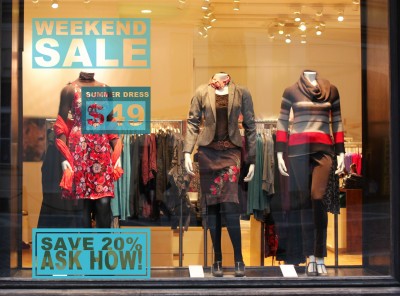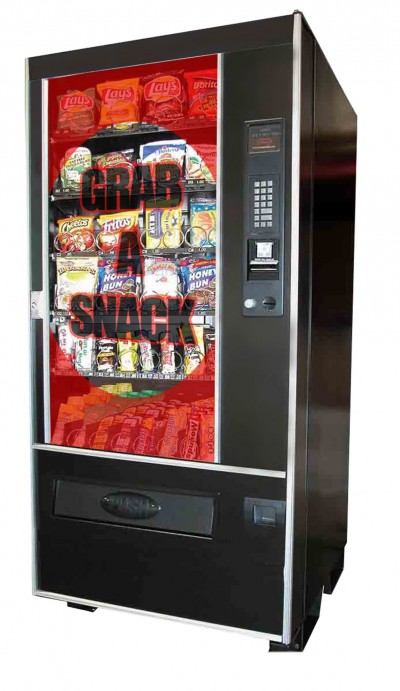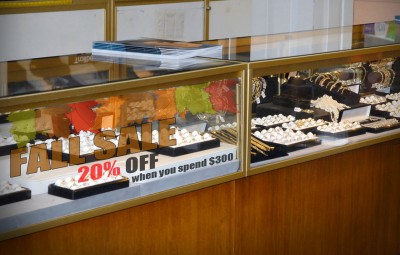The clear benefits of translucent displays
by all | 11 February 2014 8:30 am
 [1]
[1]Images courtesy Stratacache
By Chris Riegel
Traditional media channels are becoming segmented and saturated, altering today’s advertising landscape and making competition fierce for consumers’ attention. What were once broad, one-size-fits-all mass advertising efforts are now demographic-specific and targeted messages.
As the consumer’s appetite for more personalized messaging grows, marketing and advertising channels will continue to fragment at a faster pace. According to a recent study conducted by the Harvard Business Review, many consumers now cram 12 hours of traditional media exposure into only nine hours of Internet-based consumption, resulting in less viewing time per message, thus reducing advertising effectiveness.
While these consumers are still exposed to thousands of ads daily through TV, radio, the Internet, Facebook, Twitter and e-mail, performance indicators reveal mass advertising is not as effective as it was before. A crowded marketplace has left many potential customers overwhelmed with product choices, so they are filtering out, blocking and/or turning off ads.
When shopping, too, customers are doing whatever they can to avoid marketing messages. This has meant a shift of power into their hands.
For marketers to cut through the clutter, they must stress the importance of value, rather than volume, and become more creative in getting their messages heard. They need a framework to combat media fragmentation and to deliver the right message, at the right time, in the right place, to the right target audience.
 [2]
[2]One of the first applications of translucent digital signage has been in vending machines.
One new answer is translucent digital signage technology. Marketers, retailers and brand managers can now incorporate in-store advertising into any glass surface, while still allowing customers to view products behind that surface.
How it works
Printed posters and other wide-format graphics typically block the customer’s view, while digital signage has faced limits as to where it can be installed. Translucent digital signage, on the other hand, can deliver high-definition (HD) video, store coupons, surveys, games and other interactive content within a glass fixture, such as a window, freezer or cooler door, vending machine, storefront window, cosmetics counter or jewellery case.
In this way, an existing glass fixture serves a double purpose by simultaneously fostering a media experience for—and delivering valuable messages to—the customer.
Translucent digital signage combines three key elements: a translucent screen, backlighting and an embedded media player. The translucent panel typically varies in size from 1.2 to 1.8 m (46 to 70 in.).
The media player uses a solid-state hard drive, with no moving components, and a specialized processor, both of which help minimize heat generation. Video content can be updated anywhere via Internet connection.
For a freezer or cooler, the media player is built into the top portion of the door. Content delivery, command and control can all be facilitated through a wireless network connection. In an architectural, jewellery case or storefront implementation, a direct High-Definition Multimedia Interface (HDMI) video connection can be used instead. Digital signage software is used to create, schedule, control, manage and monitor content.
The right balance of backlighting is key to the successful display of translucent messaging, with each glass environment requiring its own lighting configuration. Fortunately, the standard lighting within a store’s freezer, cooler, cosmetics counter or jewellery case is generally sufficient, while architectural glass applications can often rely on ambient room lighting.
The POP advantage
Advertising messages are more powerful and persuasive when they are displayed along the consumer’s ‘path to purchase.’ A shopper who enters a store with the intention of only buying product A may well end up leaving that store with products A, B and C, thanks to the influence of digital point-of-purchase (POP) advertising.
 [3]
[3]Backlighting is key, but the standard lighting inside a jewellery case or cosmetics display, for example, will usually be sufficient.
A study by Prime Consulting Group measured the reach and frequency (r/f) of branded messaging, educational information and special promotions in drug stores. The results showed at-retail advertising was responsible for additional sales 70 per cent of the time.
In this context, the advantage of translucent digital signage technology is it extends the capabilities of at-retail advertising. Ideally, it allows marketing messages and products to both be placed within arm’s reach for the in-store customer.
As mentioned, advertisers also need to cut through the clutter to achieve their desired sales results. Focusing marketing efforts on POP displays is important, but is not enough in itself. A platform is needed that will allow a brand to stand out and draw customers away from the competition.
Translucent digital signage brings advertising to the prime, high-traffic ‘real estate’ of in-store glass surfaces where traditional signage may be obsolete. Interactive ads, especially, are well-placed for customer engagement. For retailers, interaction is one of the most valuable ways to get the consumer to remember the brand.
Instead of taking up valuable shelf space, a translucent screen keeps the customer’s focus on in-store products, with non-intrusive advertisements connecting those product types with specific brands at the coveted ‘point of decision.’
Translucent digital signage also has ‘stopping power,’ gathering other customers around to watch. Whenever one customer is interacting with promotional messaging in a fun way, it means other customers are also seeing the featured brand in a positive light. In this sense, the technology initiates both direct and indirect consumer impressions.
The value exchange
Translucent technology has the potential to successfully initiate many customer interactions, by displaying product information and incorporating touch screen capabilities. It can also offer in-store coupons and support social media interactions via Quick Response (QR) codes, which are electronically displayed and then scanned with customers’ smart phones to directly download special content, thus adding value to the shopping experience.
Dynamic applications can include interactive games featuring the product behind the glass, vote-based polls of customers’ opinions on suggested topics, music and audio accompaniment and interactive grocery shopping lists that display the ingredients needed to make a given recipe. Like other digital signage, translucent screens can also incorporate gesture-based interaction, augmented reality (AR) and virtual reality (VR) applications, among other new and advanced features.
 [4]
[4]A digital signage media player can be built into the top portion of a freezer or cooler door.
A study by market research firm Knowledge Networks (KN) Dimestore and digital advertising company SocialVibe found 90 per cent of consumers reporting they appreciate the opportunity to interact with brands, as long as the experience is initiated with some sort of value exchange, such as allowing them to earn virtual currency in a game, giving them access to music files or generating a micro-donation to a charity.
Translucent digital signage can support this type of experience with customers clicking, responding, downloading, playing and otherwise interacting. They can seek more information while being exposed to the advertised product. The greater the value of the interactive experience, the higher the level of brand recall and the more likely the consumer is to act upon it through purchasing behaviour.
Non-traditional platforms
Advertisers are already taking note of translucent digital signage and other non-traditional forms of media that can yield significant sales lift. Research firm PQ Media’s Alternative Media Forecast: 2008-2012 predicted spending on non-traditional media would comprise 26.6 per cent of all U.S.-based advertising and marketing dollars by the end of this year.
Meanwhile, industry analysts at BIA/Kelsey, in their Annual U.S. Local Media Forecast, 2011-2016, estimated local online, interactive and digital advertising revenues would climb from $21.2 billion in 2011 to $38.5 billion by 2016, representing a compound annual growth rate (CAGR) of 12.7 per cent.
In today’s crowded media environment, the most effective advertising strategy is to provide a relevant message consumers feel is worthy of their attention, delivering it in an entertaining fashion that cannot be easily ignored. Such strategies are moving brands into innovative, non-traditional platforms, including translucent digital signage.
Transforming glass from a passive to an active surface will truly remap the boundaries of advertising, focusing on currently underused POP zones and product differentiation. Whether on a grocery store’s freezer door or a bank branch’s drive-thru window, translucent displays will allow brands to connect digitally and directly with consumers.
Chris Riegel is CEO of Stratacache, which provides digital signage, Internet Protocol (IP) video and content distribution technologies to businesses. This article is based on material he presented in March at the Digital Signage Expo (DSE) in Las Vegas, Nev. For more information, visit www.stratacache.com[5] and www.digitalsignageexpo.net[6].
- [Image]: http://www.signmedia.ca/wp-content/uploads/2014/02/retail_primasee_Mock.jpg
- [Image]: http://www.signmedia.ca/wp-content/uploads/2014/02/VendingMachine.jpg
- [Image]: http://www.signmedia.ca/wp-content/uploads/2014/02/jewelry_case.jpg
- [Image]: http://www.signmedia.ca/wp-content/uploads/2014/02/PrimaSee.jpg
- www.stratacache.com: http://www.stratacache.com
- www.digitalsignageexpo.net: http://www.digitalsignageexpo.net
Source URL: https://www.signmedia.ca/the-clear-benefits-of-translucent-displays/